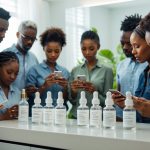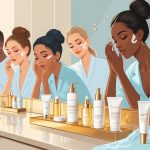Must-Have Sunscreens Quietly Adding Breakthrough Skin Benefits You’ll Notice Fast
Radiant Finish and Makeup Primer Benefits
Admittedly, I once rolled my eyes at sunscreens boasting “radiant” as a finish, picturing disco-ball shine. Then I tried the ELEMIS Pro-Collagen Marine Cream SPF 30—definitely more of a subtle, radiant complexion booster than anything garish.
It smooths skin enough that I can skip primer entirely, which means one less step most mornings. Brands know primers sell, and sunscreen–primer hybrids target people like me who want a quick, low-maintenance routine.
I’ve noticed Neutrogena’s Invisible Daily Defense blends in with zero white cast and an almost-blurring effect under makeup. These formulas tend to use silica or dimethicone for extra slip, letting foundation cling better and last longer.
Still, the real value is practicality: these radiant finish sunscreen-primers mean fewer layers, less pilling, and honestly less stress trying to get ready before my first meeting. If I can combine sun protection with a smoother base, I’m all in—if not, it just gathers dust with the rest.
Powder and Sheer Spray Formulas
My drawer is embarrassingly full of things like the Colorescience Sunforgettable Powder SPF 50. Powders seemed like a gimmick until I realized they actually work for midday touchups when slathering cream is just…not happening.
I tap the brush on my T-zone, and the finish stays matte without caking, which is huge for oily skin like mine. Then there are sheer spray sunscreens.
A bottle of Supergoop! Refreshing Mist is always in my bag—quick mist over makeup, dries in seconds, and doesn’t disrupt anything underneath. The texture is so light it’s easy to forget you’ve even reapplied.
It’s not as foolproof as creams for beach days, but unbeatable for everyday use or city walks when you just need to top up and move on. Powders and sprays still lag a bit behind in water resistance and longevity compared to lotions, but for layering during workdays or over makeup, nothing matches their convenience.
Plus, no white cast, which is all I want when the lighting in office bathrooms is already cruel.
Water-Resistant Formulas for Active Lifestyles
I can’t count how many times I’ve grabbed a so-called “sport” sunscreen only to feel betrayed mid-lap when it floats off my skin. The whole dance between water-resistant versus waterproof (which, by the way, doesn’t exist—FDA says “waterproof” is a no-go) gets old fast.
There’s nuance to which formulas actually survive sweat, pool laps, or a hot run in SPF 50+ territory, and it’s not always about the highest number or the flashiest bottle.
Who Needs Water-Resistant Protection
If you’re moving, sweating, or anywhere near water—pool, ocean, or just a sticky commute—you need a sunscreen that can actually hang on. Swimmers, runners, pickleball folks at the park: you’ll get the most from formulas labeled “water resistant (80 minutes)” like Dermasport’s. I’ve found it survives laps when most melt off, which is a minor miracle.
But it’s not just for athletes. If you’re chasing kids at a splash pad or sweating through a festival, regular lotions just don’t cut it. My dermatologist pointed out that cosmetic-only face screens won’t protect at the beach or after a sweaty bike ride. The best bets are always labeled “broad-spectrum” and at least SPF 30.
I always check the ingredient list, even if it’s just out of habit. Water resistance usually comes from film-formers like silicone derivatives or certain waxes. These can feel greasy or clogging, though. I end up cycling between Hawaiian Tropic’s Everyday Active and Banana Boat’s Sport Ultra. Both promise lightweight textures, and honestly, I need that because my skin loves to break out at the worst times.
How to Reapply for Maximum Defense
Most water-resistant sunscreens lose their punch if you don’t reapply on schedule. That’s my biggest gripe. Eighty minutes is the max for most formulas after swimming or sweating, and I’ve watched friends get burned just assuming “water resistant” means all-day coverage.
Here’s what I do, or at least try to remember:
If I’m in and out of water, I set a timer for around 60-70 minutes—before that 80-minute window. Even if I’m not sweating buckets, sand, towels, or just rubbing my face can wipe the product away. Those moments demand a quick touch-up.
Reapplying means a full layer—quarter teaspoon for face, shot glass for body. It’s wild how many people skimp to make the bottle last, but that’s just asking for sunburn.
On makeup days, I’ve tried powder SPF touch-ups, but honestly, only sprays or milky reapplication fluids (like Shiseido’s Sports BB Compact) make it easy and reliable. Shortcuts? They don’t work. Application thickness and frequency are everything for keeping that broad-spectrum protection intact.
Key Ingredients Setting New Sunscreens Apart
It’s wild how many SPF formulas now toss extra “skin benefits” onto the label. Some actually back it up with legit ingredients. I keep seeing the same heavy hitters in my own tests whenever a sunscreen claims to brighten, calm, or hydrate without making me feel like I’m wearing sticky face glue.
Antioxidants and Skin-Calming Agents
Honestly, no sunscreen—Neutrogena, Supergoop, or even those tinted ones from La Roche-Posay—seems to skip antioxidants anymore. Vitamin C shows up everywhere for its reputation with dullness and fading spots. My worry was always stability (so many serums oxidize!), but in SPF, it lasts longer and can make mineral blocks less ghostly.
Vitamin E pops up in a lot of these, often paired with vitamin C to help prevent UV-triggered skin aging. I’m a skeptic, but the research on this combo in higher-end sunscreens seems solid enough. Then there’s niacinamide (vitamin B3), which isn’t just for serums now. Brands like EltaMD or Beauty of Joseon include it for redness and barrier repair.
I’ve tested formulas with green tea extract, which always looks fancy on the bottle but actually helps calm skin after sun exposure. There’s a real difference if you’re sick of blotchy cheeks post-beach. I wish I didn’t know that from experience, but here we are.
Next-Gen Hydrators and Soothing Botanicals
Some SPFs now feel more like moisturizers—Cerave’s hydrating sunscreen probably started that trend, with ceramides showing up everywhere. These keep the skin barrier steady during outdoor workouts or marathon errands, so I don’t end up flaky by lunch. My frustration: why did it take so long for squalane to become mainstream? Biossance nailed it, but now even drugstore brands add squalane for lightweight hydration.
I keep coming back to aloe vera, which avoids stickiness and keeps my skin comfortable. A lot of Asian sunscreen brands blend aloe with centella asiatica—that cica-ingredient—because it soothes and helps me fend off redness, especially in summer. Korean favorites like Skin1004 and European launches seem obsessed with this combo.
Vitamin B5 (panthenol) is the quiet multitasker—hydrating and calming at once. It now tops ingredient lists in most “sensitive-skin” sunblocks. Whenever I wear a sunscreen loaded with all these (and yes, Bioderma’s Hydrabio line is a repeat offender), my skin actually looks less irritated after a day outside, even if I skip my usual moisturizer.



